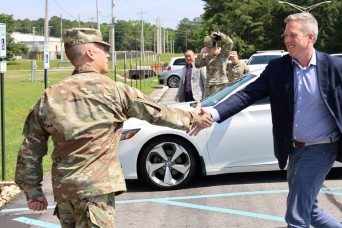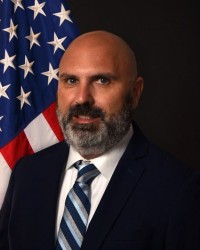-
 US Army tests laser weapons, aiming at a future of energy-based air defense
June 27, 2025
US Army tests laser weapons, aiming at a future of energy-based air defense
June 27, 2025
-
 Secretary of the Army Visits Redstone Arsenal, Reaffirms Push for Faster, Smarter Military Tech
June 16, 2025
Secretary of the Army Visits Redstone Arsenal, Reaffirms Push for Faster, Smarter Military Tech
June 16, 2025
-
 DE M-SHORAD Inducted into Fort Sill Museum, Marking a New Era in Air Defense & Tactical Innovation
June 12, 2025
DE M-SHORAD Inducted into Fort Sill Museum, Marking a New Era in Air Defense & Tactical Innovation
June 12, 2025
-
 Shielding the Pacific: Inside the Guam Defense System Joint Program Office
June 5, 2025
Shielding the Pacific: Inside the Guam Defense System Joint Program Office
June 5, 2025
-
 Advancing Military Robotics: Highlights from the U.S. Army's HMIF Networks Industry Day
October 23, 2024
Advancing Military Robotics: Highlights from the U.S. Army's HMIF Networks Industry Day
October 23, 2024
-
 Wideband Selective Propagation Radar System (WiSPR)- Valuable Technology for Warfighters
October 21, 2024
Wideband Selective Propagation Radar System (WiSPR)- Valuable Technology for Warfighters
October 21, 2024
-
 Harnessing hybrid vehicles for superior US Army operations
March 20, 2024
Harnessing hybrid vehicles for superior US Army operations
March 20, 2024
-
 DE M-SHORAD Update to Mr. Young Bang, Principal Deputy Assistant Secretary of the Army (Acquisition, Logistics and Technology)
February 22, 2024
DE M-SHORAD Update to Mr. Young Bang, Principal Deputy Assistant Secretary of the Army (Acquisition, Logistics and Technology)
February 22, 2024
-
 Groundbreaking laser prototype systems delivered to 4-60th Air Defense Artillery Regiment
September 21, 2023
Groundbreaking laser prototype systems delivered to 4-60th Air Defense Artillery Regiment
September 21, 2023
2024 RCCTO Overview Video
2023 RCCTO Video Overview
EXPERIMENT, EVOLVE AND DELIVER »
The Army Rapid Capabilities and Critical Technologies Office serves to expedite critical capabilities to the field to meet Combatant Commanders’ needs. The Office enables the Army to experiment, evolve and deliver technologies in real time to address both urgent and emerging threats, while supporting acquisition reform efforts. The Army Rapid Capabilities and Critical Technologies Office reports to a Board of Directors led by the Secretary of the Army, and including the Chief of Staff of the Army, Under Secretary of the Army, Vice Chief of Staff of the Army, Army Acquisition Executive, and the Commanding General of Army Futures Command.
The Army Rapid Capabilities and Critical Technologies Office executes rapid prototyping and initial equipping of strategically important capabilities to meet commanders’ warfighting needs, consistent with the Army’s modernization priorities. Beyond closing current capability gaps, the Office also aims to stimulate aggressive, proactive capability development and leverage disruptive technologies to meet Army strategic objectives.
The Army Rapid Capabilities and Critical Technologies Office leverages innovation by other government agencies and industry partners, as well as Warfighter feedback, to deliver solutions on an accelerated timeline.
ABOUT US »
The Army Rapid Capabilities Office was created in August 2016 to expedite the delivery of critical combat materiel capabilities to the Warfighter to meet Combatant Commanders' needs. In December 2018, its mission was expanded and its name changed to the Army Rapid Capabilities and Critical Technologies Office. The Office is headquartered at Redstone Arsenal, Alabama.
MISSION »
The Army Rapid Capabilities and Critical Technologies Office will rapidly and efficiently research, develop, prototype, test, evaluate, procure, transition, and/or field critical enabling technologies and capabilities that address near-term, and mid-term threats. The Office will produce or acquire materiel solutions consistent with the Army’s modernization priorities that maximize Soldiers’ capabilities to deploy, fight, and win on future battlefields.
ORGANIZATION »
The Army Rapid Capabilities and Critical Technologies Office reports to a Board of Directors (BoD) led by the Secretary of the Army, and including the Chief of Staff of the Army, Under Secretary of the Army, Vice Chief of Staff of the Army, Army Acquisition Executive, and the Commander of Army Futures Command. All decision-making authority related to the Office’s projects resides within the BoD and Army Rapid Capabilities and Critical Technologies Office construct.
KEY OPERATING PRINCIPLES »
Key operating principles for the Army Rapid Capabilities and Critical Technologies Office include a short and narrow chain of command, overarching programmatic insight, early and prominent Warfighter involvement, and a collaborative integrated team of functional specialists. The Army Rapid Capabilities and Critical Technologies Office leverages innovation by other government agencies and industry partners, as well as Warfighter feedback, to deliver solutions on an accelerated timeline. Ordinarily, enduring capabilities resulting from these efforts will be transitioned over to a Program Executive Office for continued production, modification, sustainment, and support. The Army Rapid Capabilities and Critical Technologies Office provides expertise not solely focused on materiel; it seeks to provide holistic solutions that inform the Doctrine, Organization, Training, Materiel, Leadership, Personnel, Facilities and Policy (DOTMLPF-P) impacts of implementing new capabilities within the operational Army.
RAPID. PROTOTYPE. DELIVER.
The U.S. Army RCCTO mission is strategically organized to rapidly deliver prototypes with residual combat capability in support of the National Defense and Army Modernization strategies. The RCCTO efforts include signature outcomes such as directed energy and critical efforts such as hybrid electric vehicle technologies and other innovative capabilities in emerging and disruptive technology areas.
RCCTO PORTFOLIO
-
The Advanced Concepts and Critical Technologies (ACCT) Project Office within the Army Rapid Capabilities and Critical Technologies Office (RCCTO) plays a crucial role in rapidly developing and testing advanced technologies. Its mission is to address high-priority needs identified by RCCTO and Army leadership while serving as a quick reaction cell for research, prototyping, and experimentation.
ACCT's mission is to swiftly develop, test, and integrate advanced technologies in response to critical requirements from RCCTO and Army leadership. It operates as a dynamic response unit, showcasing initial technology readiness and providing enduring combat capabilities.
For Soldiers, ACCT translates into direct benefits such as rapid access to advanced technologies for improved effectiveness and safety. Its quick reaction capabilities mean soldiers receive timely solutions to emerging threats, potentially saving lives.
-
Counter-small UAS prototype demonstrations include Low Collateral Effects Interceptors, Handheld Dismounted System, Ground Based Aerial Defense, High Power Microwave, and Counter UAS.
C-sUAS conducts experiments to evaluate emerging technologies.
The C-sUAS Project Office brings a synchronized approach across Joint Services.
-
The Army RCCTO CEID Project Office focuses on developing innovative technologies that address critical Army warfighter needs through experimental prototyping and demonstrations.
The mission is to rapidly advance cyber, electronic warfare, and information dominance technologies to counter emerging threats posed by adversaries integrating these capabilities into their attacks.
Soldiers benefit by having access to evolving technologies that enhance their security and effectiveness on the battlefield, ensuring operational relevance and protection against modern threats.
The Army RCCTO CEID Project Office seeks to develop innovative and disruptive technologies that meet critical Army warfighter needs and priorities through experimental prototyping and demonstrations.
-
The DEPO strategy delivers Directed Energy (DE) weapons to include a Short-Range Air Defense 50kW-class laser, indirect Fire Protection Capability-High Power Microwave, and IFPC-High Energy Laser.
Deliver Directed Energy prototypes into the hands of Soldiers.
Directed Energy weapons offer a significant defensive capability against groups 1-3 Unmanned Aircraft Systems (UAS), rotary- and fixed-wing threats, and Rocket, Artillery, and Mortar (RAM) threats.
-
RAPPO is a key player in RCCTO's technology advancement efforts, specializing in accelerating acquisitions and technology assessments.
RAPPO's mission aligns with the Army's Electrification Strategy with an emphasis on rapid innovation and transitioning operational prototypes. RAPPO also supports the FoCUS initiative in collaboration with USASOC, with RCCTO overseeing the program and C5ISR Center handling system integration.
Soldiers benefit from RAPPO's streamlined acquisitions and access to cutting-edge technologies, contributing to sustainability and efficiency.
-
Deliver persistent layered 360-degree Integrated Air and Missile Defense (IAMD) capability to defend the people, infrastructure, and territory of Guam from advanced ballistic, hypersonic and cruise missile threats.
-
The Multi-Domain Artillery Cannon System (MDACS) is a revolutionary defense solution designed to provide robust and effective protection against a broad range of threats. Comprising four key components—the Multi-Domain Artillery Cannon (MDAC), Multi-Function Precision Radar (MFPR), Multi-Domain Battle Manager (MDBM), and Hypervelocity Projectiles (HVP)—MDACS offers both integrated and standalone Air Missile Defense (AMD). This scalable and rapid-response capability leverages advanced technologies to detect, track, and engage threats in a rapidly changing environment, ensuring the safety and security of personnel, assets, and critical infrastructure.
DIRECTOR OF HYPERSONICS, DIRECTED ENERGY, SPACE, AND RAPID ACQUISITION
-
 LTG Robert A. Rasch, Jr.
LTG Robert A. Rasch, Jr.
DEPUTY DIRECTOR OF HYPERSONICS, DIRECTED ENERGY, SPACE, AND RAPID ACQUISITION
-
 Mr. Warren O'Donell
Mr. Warren O'Donell
ADVANCED CONCEPTS AND CRITICAL TECHNOLOGIES
-
 Director, Advanced Concepts and Critical TechnologiesMr. Robert Monto, Jr.
Director, Advanced Concepts and Critical TechnologiesMr. Robert Monto, Jr.
COUNTER-SMALL UNMANNED AIRCRAFT SYSTEMS
-
 Deputy Director, RCCTO Counter s-UAS | Chief, JCO Acquisition & Resource DivisionCOL RAYMOND YU
Deputy Director, RCCTO Counter s-UAS | Chief, JCO Acquisition & Resource DivisionCOL RAYMOND YU
CYBER, ELECTRONIC WARFARE, AND INFORMATION DOMINANCE
-
 Director - Cyber, Electronic Warfare and Information DominanceMr. Julian Williams
Director - Cyber, Electronic Warfare and Information DominanceMr. Julian Williams
DIRECTED ENERGY PROJECT OFFICE
-
 Director, Directed Energy Project OfficeMr. Adam Aberle
Director, Directed Energy Project OfficeMr. Adam Aberle
RAPID ACQUISITION PROTOTYPING PROJECT OFFICE
-
 Director, Rapid Acquisition Prototyping Project OfficeMr. Michael "Mike" Foster
Director, Rapid Acquisition Prototyping Project OfficeMr. Michael "Mike" Foster
MULTI-DOMAIN ARTILLERY CANNON SYSTEM
-
 Product Manager, Multi-Domain Artillery Cannon SystemLTC Steven Hoak
Product Manager, Multi-Domain Artillery Cannon SystemLTC Steven Hoak
MEDIA AND GENERAL PUBLIC INQUIRIES
INNOVATION OPPORTUNITIES
The RCCTO has a Broad Agency Announcement (BAA) available on sam.gov and grants.gov. The BAA is directed at advancing state-of-the-art technologies and increasing understanding that would lead to innovations.
This BAA is a continuously open announcement and the RCCTO will periodically make amendments, which will be publicized as special notices on the sam.gov and grants.gov websites. These special notices will detail specific areas of interest and solicit information and solutions.


